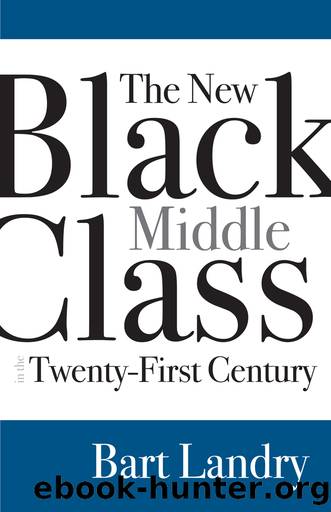The New Black Middle Class in the Twenty-First Century by Bart Landry

Author:Bart Landry [Landry, Bart]
Language: eng
Format: epub
Tags: Social Science, General, Ethnic Studies, African American Studies, Social Classes & Economic Disparity, Political Science, Civil Rights, Discrimination & Race Relations, Public Policy, Social Policy
ISBN: 9780813593975
Google: 7P-9DwAAQBAJ
Publisher: Rutgers University Press
Published: 2018-07-20T05:25:18+00:00
7
From School to Work
A college degree is the second stage, but only the second stage, in the attainment process. Saying that does not diminish the significance of education but signals that the attainment process is not yet complete. From the point of view of Weber, a college degree is a âcoinâ to be traded in the market for one of the many positions of the middle class. This is true regardless of race, ethnicity, or gender. Yet the graduateâs race, ethnicity, or gender has historically influenced this transition in a positive or negative manner. The negative impact of race was reflected in the remarks of Patrick Harrington, whom I quoted in the last chapter complaining of the limited range of occupations open to black college graduates during the 1970s. In chapter 2 of my 1987 book, The New Black Middle Class, I discussed improvements in the occupational attainment of members of the new black middle class compared to those in the old black middle class. While the old black middle class was restricted to professional occupations serving the black community, the new black middle class that emerged after the Civil Rights Act of 1964 entered a greater variety of occupations, including many in mainstream areas of the economy. It remains to be seen whether this trend continued during the decades following the civil rights era. The increase in black studentsâ college and graduate school attainment, documented in chapter 6, suggests that much has also changed in the occupational attainment of blacks over the past decades. Whether this change has brought occupational parity with whites in the twenty-first century is the question I will now turn to using both discrete occupational rankings and a summary measure of inequality, the index of dissimilarity (ID).
The index of dissimilarity is a measure of the change that must occur to equalize two distributions. Its variation from 0 to 100 makes it an intuitive and useful measure in social science research. Any number over 0 indicates the percentage of individuals who would have to change place to equalize two distributions. In a comparison of the occupational distributions of blacks and whites, any number greater than 0 represents the percentage of black workers who would need to upgrade occupations to equalize their occupational distributions with that of white workers. An index of 0 would designate parity in their occupational distributions.1 I use the IPUMS-USA data in this comparison for the years 1970, 1980, 1990, and 2000.2 For these comparisons, I focus only on those middle-class occupations classified as âprofessionalâ by the Census Bureau. These, along with administrative/executive occupations, are âupper-middle-classâ occupations and are therefore a test of black achievement at the highest level of the occupational structure. What does a comparison of the dissimilarity index tell us about black upper-middle-class achievement since 1970?
In 1970, the ID for the occupational distributions of all black and white professionals (males and females) was 0.256, showing that almost 26 percent of blacks would have had to change occupations (upgrade) to produce equal racial distributions.
Download
This site does not store any files on its server. We only index and link to content provided by other sites. Please contact the content providers to delete copyright contents if any and email us, we'll remove relevant links or contents immediately.
Nudge - Improving Decisions about Health, Wealth, and Happiness by Thaler Sunstein(7615)
iGen by Jean M. Twenge(5366)
The Fire Next Time by James Baldwin(5249)
Adulting by Kelly Williams Brown(4487)
The Hacking of the American Mind by Robert H. Lustig(4318)
The Sports Rules Book by Human Kinetics(4294)
The Ethical Slut by Janet W. Hardy(4173)
Captivate by Vanessa Van Edwards(3795)
Mummy Knew by Lisa James(3634)
In a Sunburned Country by Bill Bryson(3483)
The Worm at the Core by Sheldon Solomon(3435)
Ants Among Elephants by Sujatha Gidla(3417)
The 48 laws of power by Robert Greene & Joost Elffers(3024)
Suicide: A Study in Sociology by Emile Durkheim(2973)
The Slow Fix: Solve Problems, Work Smarter, and Live Better In a World Addicted to Speed by Carl Honore(2947)
Humans of New York by Brandon Stanton(2835)
The Tipping Point by Malcolm Gladwell(2827)
Handbook of Forensic Sociology and Psychology by Stephen J. Morewitz & Mark L. Goldstein(2658)
The Happy Hooker by Xaviera Hollander(2655)
